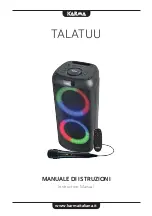
29/48
3301069/A
EN
LIFTING AND TRANSPORT
• Disconnect the device from the power supply before transporting it.
• If the device is equipped with one or more components such as a transport trolley, inert gas cylinder, wire feeder or
wire coil, remove them before transporting it.
• During transport of the device, ensure that all applicable local accident prevention guidelines and regulations are
observed.
• If the device is equipped with a handle or carrying strap, use it exclusively for carrying by hand.
• To lift the device by mechanical means, use eye bolts (if present), belts or chains.
DISPOSING OF ELECTRICAL AND ELECTRONIC EQUIPMENT
Do not dispose of electrical equipment together with normal waste!
In accordance with the European Directive on the disposal of waste electrical and electronic equipment and
its transposition into national legislation, end-of-life electrical equipment must be collected separately and
sent to an environmentally compliant recycling plant. Failure to comply with the European Directive and
local legislation can have hazardous repercussions on health and the environment.
1.1 Warning plate.
The following numbered text reflects the numbered boxes
on the plate.
B. Wire feed rollers can injure the hands.
C. The welding wire and wire feeder unit are live during
welding. Keep hands and metal objects well away.
1.1 Electric shocks caused by the welding electrode or
cable can be fatal. Protect yourself properly against
the risk of electric shocks.
1.2 Wear insulated gloves. Never touch the electrode with
bare hands. Never wear damp or damaged gloves.
1.3 Insulate yourself from the workpiece and the ground.
1.4 Disconnect the supply cable plug before working on
the machine.
2.
Inhaling fumes produced by welding can be harmful
to the health.
2.1 Keep your head away from the fumes.
2.2 Use a forced ventilation system or local exhaust to re
-
move fumes.
2.3 Use a suction fan to remove fumes.
3.
Sparks generated by welding can cause explosions or
fires.
3.1 Keep flammable materials well away from the wel
-
ding area.
3.2 Sparks caused by welding can cause fires. Keep an
extinguisher nearby and ensure that someone is ready to use it.
3.3 Never weld with closed containers.
4.
Arc rays may injure the eyes and burn the skin.
4.1 Wear a safety helmet and goggles. Use appropriate ear protectors and overalls with the collar buttoned up. Use
helmet masks with filters of the correct grade. Wear a full-body protection.
5.
Read the instructions before using the machine or carrying out any operation on it.
6.
Do not remove or cover warning labels.
Summary of Contents for 465.01
Page 11: ...11 25 3301069 A IT 5 5 5 48 0 1 3 4 2 fig 4a fig 4b ...
Page 25: ...25 25 3301069 A IT 9 DIAGRAMMA TEMPORIZZAZIONI DEL PROCESSO PLASMA WELDING ...
Page 35: ...35 48 3301069 A EN 5 5 5 48 0 1 3 4 2 fig 4a fig 4b ...
Page 48: ...48 48 3301069 A EN 9 PLASMA WELDING PROCESS TIMING DIAGRAM ...
Page 58: ...58 76 3301069 A ES 5 5 5 48 0 1 3 4 2 fig 4a fig 4b ...
Page 72: ...72 76 3301069 A ES 9 DIAGRAMA DE TEMPORIZACIONES DEL PROCESO PLASMA WELDING ...
Page 73: ...73 76 3301069 A 3301069 ...
Page 74: ...74 76 3301069 A ES ...
Page 75: ...75 76 3301069 A ES ...
















































